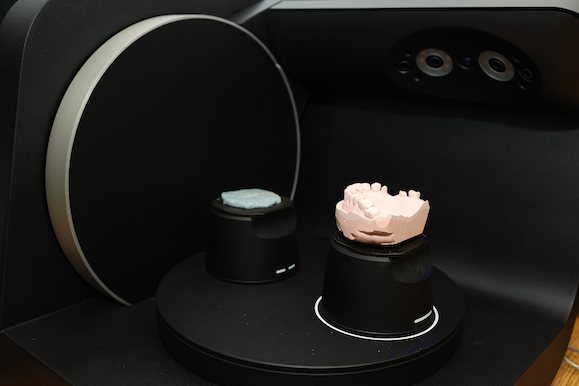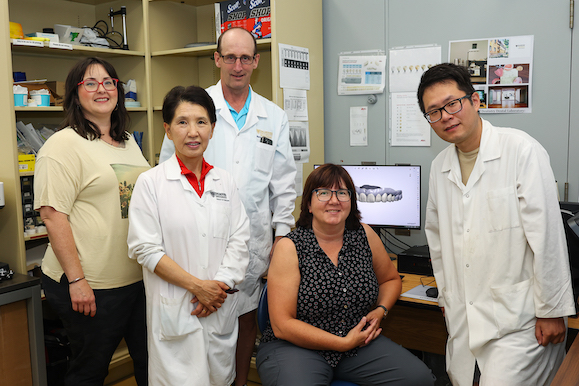l to r: Marsha Sheppard, Yeong Mi Baek, Mark Rudderham, Brenda Landry, Bob Wu. Missing: Richard Redhead and John Matthew (Bruce Bottomley photos)
Tucked into a quiet corner of the third floor of the Dentistry Building sits the only in-house full-service dental laboratory to be found in a Canadian university. In operation for over 40 years, the lab creates the bulk of crowns, bridges, dentures, bite planes, orthodontic appliances, and other devices that are used in the Faculty of Dentistry clinics.
Ìý
Over the past 10 years, digital technology has transformed the way the lab works – and is continuing to do so. A new 3Shape digital scanner system, which arrived in May, is a "remarkable advancement on our current digital capabilities", says team lead Brenda Landry.
Ìý
Two older model scanners, a Nobel Biocare Kavo LS3 and a Dentsply Sirona InEos X5, continue do a lot of heavy lifting for the Faculty, helping to produce the crowns, bridges, and other items the students need.
Ìý
Mark Rudderham, one of the lab technicians, says that the students first learn to produce traditional plaster casts from impressions taken of patients’ mouths. As they progress through their studies, they learn how to use intraoral wands on patients in the clinic to create prime scans. Scans of both the plaster casts and prime scans are then sent digitally to the scanner in the lab where 3D printed models can be fabricated. These files are also used in the digital design process.
Ìý
 What the 3Shape adds to the lab’s capabilities is its capacity for design. For a crown bridge, for example, Landry explains that "we mark the margins from the scan received and, using the CAD software and extensive tooth library, we can design the crowns for optimum contour and function".
What the 3Shape adds to the lab’s capabilities is its capacity for design. For a crown bridge, for example, Landry explains that "we mark the margins from the scan received and, using the CAD software and extensive tooth library, we can design the crowns for optimum contour and function".
Ìý
The lab team currently designs bite planes, crowns, implants and bridges with it and are learning how to design cast removable partial denture frameworks (RPD) digitally. The designs for the RPDs are sent out to Selective Laser Melting for 3D printing and casting at the moment, but the aim is to produce these in-house in the future.
Ìý
New knowledge, new options
Bob Wu joined the lab team as a dental technician two years ago after previously working in a private lab. "Bob came to us with a wealth of digital knowledge", says Landry. "He was also familiar with the 3Shape system and helped us realize we needed it here to be able to move our capabilities forward."
Ìý
Wu says that one of the many advantages of the new equipment is that you can do a digital smile wax up based on a 2D image of a patients face digitally layered over a current arch scan. This new technique gives dental students and instructors a better vision of what the finished product will look like and helps them devise the final treatment plan.
Ìý
Landry adds that another advantage is student education. Students can go into the lab to see the digital image of their scans. "If any alterations need to be made to a prep, the students can make the changes while the patient is still in the chair, saving them valuable appointment time."
Ìý
When the design of crown is finished, it is sent to the lab’s milling machine where it is milled with the appropriate burs in the zirconia’s "green" state. The crown is then placed into a sintering furnace that heats it to greater than 1500 degrees Celsius, which cures the zirconia and shrinks the crown to the perfect size.
Ìý
 Eyes on the future
Eyes on the future
Producing dental appliances this way means that far fewer items need to be sent to outside labs to be produced, making production much more economical. Production is also more accurate and faster and involves fewer health risks from inhaling dust for those who operate the equipment. There is also less material waste, which is better for lab safety, workflow efficiency, and the environment. The software for the scanner can also be updated.
Ìý
The lab team is delighted with the new scanner and the possibilities it offers. They also have their eyes on a new milling machine with an automatic loader that would process multiple jobs more quickly and accurately, with a reduced risk of error, resulting in fewer appointments and greater comfort for patients.
Ìý
Landry says the transition from manual fabrication to digital was overwhelming at first. But the team appreciates that it brings a more consistent and efficient way of working. Now, when asked what the most exciting aspect of digital dentistry is, Rudderham immediately replies "constant change and adapting to new technology".
Ìý
The digital dentistry team of Richard Redhead and Bob Wu and faculty members continue to assess the advantages of new and emerging technology.
Recent News
- DentDays 2024: A time to reconnect and celebrate
- 2024 Academic Awards Celebration: "We did it together"
- Dr. Frank Lovely and his network of influence
- New mural celebrates partnership and better health for all
- Meet Krysti Campbell: 2024 OAA recipient
- Meet Dr. Linda Blakey: 2024 OAA recipient
- A taste for history
- How I spent my summer: Seeing the light in the lab

